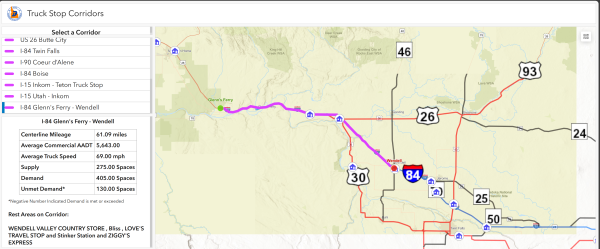The Infrastructure Investment and Jobs Act (IIJA)’s Carbon-Reduction Program encourages state DOTs to pursue projects and strategies that lower transportation-related emissions. With a significant shortage of safe and reliable truck parking statewide, ITD decided to use the funding to address this need.
Collaboration by ITD’s Planning team, GIS team and the Federal Highway Administration developed a tool to bring together data, maps, and analysis to help the department evaluate potential truck-parking projects across the state highway system.
“The Truck Parking Demand Tool provides information for stakeholders and ITD staff to evaluate existing and propose new projects to expand our truck-parking network,” explained Abby Peterson, ITD Senior Planner.
The tool helps staff and partners:
- Identify areas of demand.
- Look at options for adding spaces.
- Show the economic and environmental benefits of potential projects.
The tool also provides an easy-to-use, data-driven resource to identify truck-parking needs, analyze options, and make informed decisions.
It was most recently used to identify needs and fund improvements at the Bliss Rest Area in southern Idaho, shown at left.
“For communities, more available parking cuts down on unnecessary idling and emissions from trucks circling in search of spaces, directly supporting cleaner air and healthier environments,” Peterson said. “For the freight industry, efficient access to safe parking reduces delays, keeps goods moving, and strengthens supply chain reliability.”
Key ITD personnel involved in the development of the tool include Abby Peterson (Planning), Will Thoman (GIS), Freight Manager Caleb Forrey, ITD’s Planning and GIS teams, and FHWA Division staff. Pictured at right are Forrey, Peterson and Thoman.
The issue of truck parking has been in the news several times recently:
Inside America’s $100 Billion Truck Parking Crisis
New FHWA Chief Under Pressure to Fix Truck Parking

